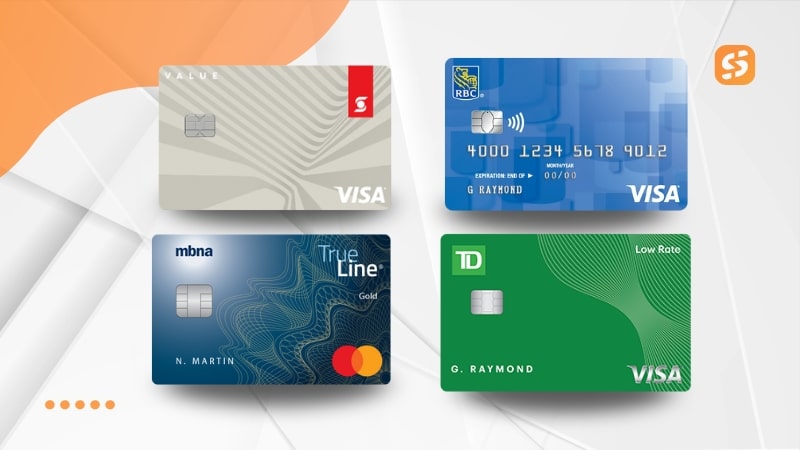Anúncios
Finding the best low interest credit card in Canada can be a game-changer for anyone looking to save money and manage debt wisely. In a country where the average credit card interest rate hovers around 20%, choosing a card with a significantly lower rate can make all the difference in your financial health.
In this complete guide, we will explore what a low-interest card truly means, how to compare the top options available in Canada, and how to use them strategically to reduce costs and increase control over your finances. By the end, you’ll know exactly which features to look for and how to choose the best low interest credit card for your lifestyle.
So, whether you’re dealing with an existing balance or simply want to prepare for emergencies, understanding low-interest credit cards is one of the smartest moves you can make for your financial well-being.
What Does “Low Interest” Actually Mean?
In Canada, most traditional credit cards charge annual interest rates between 19% and 22% on purchases. However, a low interest credit card offers a much lower rate, usually between 8% and 13%. That difference might seem small at first, but in real numbers, it can save you hundreds of dollars every year.
Imagine carrying a balance of $2,000. On a typical 19.99% card, you could pay over $300 in annual interest. With a low-rate card at 10.99%, that cost drops by nearly half. This is the essence of why finding the best low interest credit card matters: you keep more of your money instead of giving it away in interest.
Anúncios
Low-interest cards are particularly ideal for people who occasionally carry a balance or are paying off existing debt. Instead of focusing on cashback or rewards, these cards are designed to minimise your costs when life gets expensive.
Why the Best Low Interest Credit Card Matters
Choosing the best low interest credit card in Canada is not just about paying less, it’s about creating long-term financial balance. Even a small difference in interest rates can translate into significant savings over time.
For example, reducing your rate from 19.99% to 10.99% could save hundreds of dollars each year, giving you more freedom to invest, travel, or simply enjoy peace of mind when unexpected expenses arise.
Anúncios
Furthermore, these cards provide flexibility when life doesn’t go as planned. Whether you’re facing car repairs, medical bills, or temporary income gaps, a lower interest rate helps you stay in control without falling into unmanageable debt.
Many Canadians also appreciate that some low-rate options now include valuable extras, such as Credit Cards With Travel Insurance, offering trip protection and security while keeping borrowing costs minimal.
In addition, using a low interest card responsibly can strengthen your credit profile. Because the interest is lower, it becomes easier to pay down balances and maintain a healthy credit utilization ratio.
Over time, this disciplined use improves your credit score, which may unlock better financing opportunities, from mortgages to personal loans, all while reducing financial stress.
Ultimately, the best low interest credit card gives you stability, savings, and confidence. It allows you to manage debt strategically, build financial resilience, and still enjoy essential benefits that make everyday spending safer and more convenient.
In an economy where every dollar counts, choosing a card that combines low rates with useful protections like travel insurance is one of the smartest financial decisions you can make.
Key Features to Look for in the Best Low Interest Credit Card
When choosing your card, remember that the lowest advertised rate isn’t the only thing that matters. Here are the essential factors that define the best low interest credit card in Canada:
- Ongoing Purchase Interest Rate: Focus on the permanent rate, not temporary promotions. Many cards start with 0% or 1% introductory offers but jump back to 20% after six months. The real value lies in the ongoing annual percentage rate (APR). Anything between 8% and 13% is considered excellent.
- Annual Fee: Some cards charge a small annual fee (around $25 to $39) to support the low interest rate. Others are completely free. If you plan to carry a balance, a small fee can be worth it for the savings on interest. However, if you pay in full most months, a no-fee option may make more sense.
- Balance Transfer Terms: Many Canadians use low-interest cards to consolidate debt from higher-rate accounts. Before transferring, check whether there’s a transfer fee (often 2% to 3%) and what the rate will be after the promotional period ends.
- Cash Advance Interest Rate: Even low-interest cards can charge higher rates for cash advances. Avoid taking out cash unless absolutely necessary, and always read the fine print.
- Other Features and Perks: While rewards aren’t the main attraction, some low-interest cards still offer small cashback bonuses, purchase protection or extended warranty coverage. Consider these as secondary advantages, the primary goal is saving on interest.
Top Contenders for the Best Low Interest Credit Card in Canada

Now that you know what to look for, let’s explore the most reliable options available in Canada right now. These cards consistently appear among the best-rated low-interest choices across major Canadian banks.
1 – Scotiabank Value Visa
The Scotiabank Value Visa is a popular option for Canadians seeking balance-transfer flexibility. It offers a temporary promotional rate for new transfers and a standard purchase rate around 13.99% afterward. With a modest annual fee and nationwide acceptance, it’s an excellent pick for anyone consolidating existing credit card debt.
2 – RBC Visa Classic Low Rate Option
The Royal Bank of Canada’s Visa Classic Low Rate card provides one of the most stable rates in the market, approximately 12.99% on both purchases and cash advances. This predictability makes it one of the best low interest credit card choices for those who carry balances regularly. The annual fee is affordable, and RBC’s online banking tools make managing payments simple.
3 – MBNA True Line Gold Mastercard
If you’re looking for one of the lowest ongoing interest rates in Canada, the MBNA True Line Gold Mastercard is a standout. Its typical rate is around 10.99% with an annual fee near $39. While it doesn’t offer premium rewards, it’s designed purely for cost efficiency, a great match for people who prioritise saving money over collecting points.
4 – TD Low Rate Visa
The TD Low Rate Visa is another competitive option with rates starting near 12.90% on purchases. It combines flexibility with the trust of one of Canada’s biggest banks. For individuals with consistent spending and responsible payment habits, it provides both convenience and affordability.
How to Choose the Right Card for You
Selecting the best low interest credit card isn’t just about comparing numbers. It’s about aligning your card with your financial habits.
If you often carry a balance, prioritise the card with the lowest ongoing rate. For those consolidating debt, look for a strong balance-transfer offer. And if you value stability and a long-term banking relationship, choose a card from an institution you already trust.
Here’s a quick way to decide:
- Do you carry a balance most months? → Pick the card with the lowest ongoing APR.
- Are you transferring debt? → Focus on a card with a low or zero balance-transfer rate for 6–12 months.
- Do you pay in full most of the time? → Consider whether the low-interest benefit outweighs the potential rewards of other cards.
How to Use a Low Interest Card Strategically
Getting approved for the best low interest credit card is only the beginning. To truly benefit, you need to use it wisely:
- Always pay more than the minimum. This reduces your balance faster and minimises total interest paid.
- Set up automatic payments. Avoid missed due dates that can trigger penalty rates.
- Keep your balance below 50% of your limit. This helps maintain a healthy credit score.
- Avoid unnecessary cash advances. These often start accruing interest immediately.
- Re-evaluate every 12 months. Compare rates annually to ensure you’re still getting the best deal.
Using your card strategically means treating it as a financial tool, not a source of extra income.
Common Mistakes to Avoid
Even when you choose the best low interest credit card, it’s easy to fall into traps that negate its benefits. Avoid these frequent mistakes:
- Ignoring the fine print: Always read the full terms before applying.
- Focusing only on the promotional period: Low intro rates can be misleading if the post-promo rate is high.
- Overusing the card: A low rate is not an excuse to increase spending.
- Missing payments: A single late payment can raise your rate and damage your credit score.
- Overlooking fees: Annual and balance-transfer fees still affect your total cost.
Being mindful of these pitfalls ensures you get the maximum advantage from your card.
Who Benefits Most from a Low Interest Credit Card?
The best low interest credit card is ideal for several types of users:
- People paying off debt: The reduced rate means more of your payment goes toward principal, not interest.
- Budget-conscious households: Families trying to manage expenses benefit from predictable, lower borrowing costs.
- Students and young professionals: New credit users can build a good credit history while keeping interest manageable.
- Small business owners: Entrepreneurs can use low-interest cards to finance short-term needs without resorting to expensive lines of credit.
Conclusion
Choosing the best low interest credit card in Canada isn’t just a short-term decision; it’s a step toward smarter money management. It teaches discipline, reduces financial stress, and keeps your debt under control even when life gets unpredictable.
While rewards cards get most of the attention, low-interest options quietly help Canadians save thousands every year. They don’t promise luxury points, they deliver peace of mind.
So before you sign up for a flashy bonus offer, ask yourself one question: “Do I carry a balance?” If the answer is yes, the best low interest credit card is not just an option, it’s your most valuable financial ally.



















